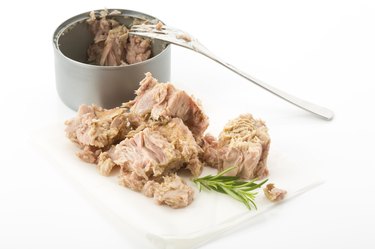
The next time you open a can of tuna expecting to have a healthy salad or sandwich, think again. You might be surprised at what's in that tuna. While tuna offers hearth-healthy omega-three fatty acids, as well as vitamins and minerals, your canned tuna could also harbor mercury, too much sodium, histamines and bacteria.
Mercury
Video of the Day
Canned tuna contains mercury, a heavy metal that can be toxic in small doses. Tuna swim in waters that contain high amounts of methylmercury, a substance that can impair the nervous system, particularly in fetuses, infants and young children. Albacore tuna has higher levels of mercury than light tuna, according to the Environmental Protection Agency and the Food and Drug Administration. In a joint consumer advisory, the two agencies recommended restricting your albacore tuna to no more than 6 oz. per week. Underscoring that concern, researchers at Rutgers University in Piscataway, New Jersey, concluded that mercury levels in albacore tuna may have been underestimated. Their research was published in the November 2004 issue of "Environmental Research."
Video of the Day
Sodium
Sodium is a mineral essential for human life. When consumed in high amounts, however, sodium can increase your blood pressure and risk of stroke. Tuna contains sodium, and many canned tuna products have added sodium. If you eat canned tuna, choose the product with low sodium or no added salt.
Bacterial Contamination
As with other foods, there is a risk that canned tuna can be contaminated with pathological bacteria, such as Clostridium botulinum, Salmonella, Shigella, Campylobacter jejuni and Escherichia coli, which can cause food poisoning and even death. Symptoms can include diarrhea, vomiting and stomach cramps four to 36 hours after ingestion. In June 2010, Tri-Union Seafoods, the parent of Chicken of the Sea, recalled 1,105 cases of white tuna packed in water tuna. The FDA said the tuna was being recalled because of possible pathological contamination due to loose seals and seams in the cans.
Histamine
Histamine poisoning, also called scrombroid poisoning, can occur if the canned tuna isn't handled properly after it's opened. Histamine forms when the free amino acid histidine and bacteria inherent in the tuna interact. Once the can is opened, the tuna should be eaten within two hours or refrigerated. The Center for Food Safety for Hong Kong's Special Administrative Region issued an advisory on histamine poisoning, and in the United States, the Centers for Disease Control and Prevention has looked at cases of histamine poisoning in fresh tuna. The FDA reports reported incidents of histamine poisoning have declined since the initial reports.
- University of Maryland Medical Center; Omega-3 Fatty Acids; June 25 2009
- Center For Food Safety The Government of the Hong Kong Special Administrative Region; Histamine in Canned Fish and Tuna Sandwiches; December 30 2006
- Centers For Disease Control and Prevention; Scombroid Fish Poisoning Associated with Tuna Steaks --- Louisiana and Tennessee, 2006; August 17 2007
- United States Environmental Protection Agency; Consumption Advice: Joint Federal Advisory for Mercury in Fish; 2004
- "Environmental Research"; Mercury in Canned Tuna: White Versus Light and Temporal Variation; Joanna Burger; Nov 2004
- Centers For Disease Control and Prevention; Sodium: The Facts; 2010
- University of Maryland Medical Center; Food Poisoning; 2011
- MedlinePlus; E. Coli Infections; June 13 2011